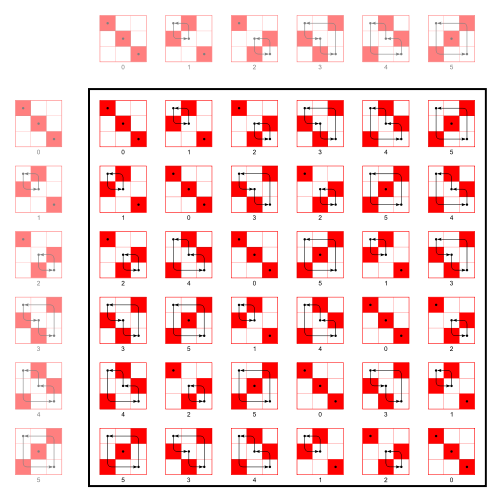This post is devoted to certain properties of random permutation matrices. Let \( {\mathfrak{S}_n} \) be the symmetric group, \( {n\geq2} \), and let \( {\mathcal{P}_n} \) be the group of \( {n\times n} \) permutation matrices, obtained by the isomorphism \( {\sigma\in\mathfrak{S}_n\mapsto P_\sigma={(\mathbf{1}_{j=\sigma(i)})}_{1\leq i,j\leq n}} \). We know that \( {\mathcal{P}_n} \) is a subgroup of the orthogonal group \( {\mathbb{O}_n} \). It is also the set of extremal points of the Birkhoff polytope \( {\mathcal{B}_n} \) formed by doubly stochastic matrices (these matrices with entries in \( {[0,1]} \) with rows and columns all summing to one). The uniform probability measure on \( {\mathcal{P}_n} \), which gives mass \( {1/n!} \) to every atom, is a Haar measure (left and right translation invariant). We denote by \( {J} \) the \( {n\times n} \) matrix with all entries equal to \( {1} \). We have \( {\frac{1}{n}J\in\mathcal{B}_n} \).
Theorem 1 (Moments and fixed points) Let \( {k\geq1} \) and \( {\psi_n(k):=\mathrm{Card}\{1\leq r\leq n:r \vert k\}} \). If \( {P} \) is a random matrix uniformly distributed on \( {\mathcal{P}_n} \), and \( {F_k:=\mathbb{E}(P^k)} \), then
\[ \mathrm{diag}(F_k)=\frac{\psi_n(k)}{n}I \quad\text{and in particular}\quad \mathrm{Tr}(F_k)=\psi_n(k). \]
If \( {\sigma} \) is a random permutation uniformly distributed on \( {\mathfrak{S}_n} \), then
\[ \mathbb{E}(\mathrm{Card}\{1\leq i\leq n:\sigma^k(i)=i\}) =\psi_n(k). \]
Note that \( {n\mapsto\psi_n(k)} \) grows until \( {\psi_k(k)=\mathrm{Card}\{1\leq r\leq k:r\vert k\}} \).
Proof: The second part follows from the first part since if \( {P_\sigma:={(\mathbf{1}_{j=\sigma(i)})}_{1\leq i,j\leq n}} \) then \( {P^k\overset{d}{=}P_\sigma^k=P_{\sigma^k}} \), and \( {\mathrm{Tr}(P_{\sigma^k})=\mathrm{Card}\{1\leq i\leq n:\sigma^k(i)=i\}} \), and thus
\[ \mathrm{Tr}(F_k) =\mathbb{E}(\mathrm{Tr}(P_{\sigma^k})) =\mathbb{E}(\mathrm{Card}\{1\leq i\leq n:\sigma^k(i)=i\}). \]
To establish the first part, we write, for all \( {1\leq i\leq n} \),
\[ (F_k)_{i,i} =\mathbb{E}((P_{\sigma^k})_{i,i}) =\mathbb{E}(\mathbf{1}_{\sigma^k(i)=i}) =\mathbb{P}(\sigma^k(i)=i) =\frac{1}{n!}\sum_{\sigma\in\mathfrak{S}_n}\mathbf{1}_{\sigma^k(i)=i}. \]
Now \( {i} \) is a fixed point of \( {\sigma^k} \) iff \( {i} \) belongs to a cycle of \( {\sigma} \) of length \( {r} \) such that \( {r\vert k} \). There are
\[ A_{n-1,r-1}=\frac{(n-1)!}{(n-1-(r-1))!}=\frac{(n-1)!}{(n-r)!} \]
ways to choose this cycle, and \( {(n-r)!} \) ways to permute the elements outside this cycle. Therefore
\[ \frac{1}{n!}\sum_{\sigma\in\mathfrak{S}_n}\mathbf{1}_{\sigma^k(i)=i} =\frac{1}{n!}\sum_{\substack{1\leq r\leq k\\r\vert k}}\frac{(n-1)!}{(n-r)!}(n-r)! =\frac{\psi_n(k)}{n}. \]
☐
Theorem 2 (Structure of \( {F_k} \)) With the settings of theorem 1, we have
\[ F_k =\frac{\psi_n(k)-1}{n-1}I +\left(1-\frac{\psi_n(k)-1}{n-1}\right)\frac{1}{n}J. \]
In particular, the matrix \( {F_k} \) belongs to the interval \( {[I,\frac{1}{n}J]} \) in \( {\mathcal{B}_n} \).
Proof: Let \( {\sigma} \) be a random permutation following the uniform distribution on \( {\mathfrak{S}_n} \), as in theorem 1. For any fixed \( {\tau\in\mathfrak{S}_n} \), we have \( {\tau\sigma\overset{d}{=}\sigma\overset{d}{=}\sigma\tau} \), and thus
\[ P_\tau C_\tau=F_k=C_\tau P_\tau \]
where \( {C_\tau=\mathbb{E}(P_\sigma\underbrace{P_\tau P_\sigma\cdots P_\tau P_\sigma}_{k-1\text{ times}})} \). Therefore, for any \( {\tau\in\mathfrak{S}_n} \),
\[ P_{\tau^{-1}}F_k=F_kP_{\tau^{-1}}=C_\tau \ \ \ \ \ (1) \]
and thus, for any \( {\tau\in\mathfrak{S}_n} \)
\[ P_{\tau^{-1}}F_kP_{\tau}=F_k. \]
In other words, for any \( {\tau\in\mathfrak{S}_n} \) and any \( {1\leq i,j\leq n} \),
\[ (F_k)_{\tau(i),\tau(j)}=(F_k)_{i,j}. \]
Thus \( {(F_k)_{i,i}=(F_k)_{1,1}} \) and \( {(F_k)_{i,j}=(F_k)_{1,2}} \) for any \( {1\leq i\neq j\leq n} \). Since \( {F_k} \) is a stochastic matrix, we have \( {1=F_{1,1}+(n-1)F_{1,2}} \). Now theorem 1 gives \( {F_{1,1}=\frac{\psi_n(k)}{n}} \), and the value of \( {F_{1,2}}\) follows. ☐
Algebra. For \( {k=1} \), the formula (1) allows to determine \( {F_1} \) without using theorem 1. Namely, for \( {k=1} \), we have \( {C_\tau=\mathbb{E}(P_\sigma)=F_1} \), and thus \( {P_\tau F_1=F_1=F_1P_\tau} \). Therefore \( {F_1} \) has all its rows identical, and all its columns identical, and thus all its entries identical. Since \( {F_1} \) is a stochastic matrix, we obtain \( {F_1=\frac{1}{n}J} \) and we recover in particular that \( {\mathrm{Tr}(F_1)=1=\psi_n(1)} \). For \( {k>1} \), the matrix \( {C_\tau} \) depends on \( {\tau} \), and we ignore how to deduce \( {F_k} \) by using simply the translation invariance of the law of \( {\sigma} \), without using the combinatorics of the cycles structure of \( {\sigma} \).
Blocs and cycles. We may play with the cycles decomposition of \( {\sigma} \) using matrices. Namely, we know that \( {P_\sigma} \) is conjugated in \( {\mathcal{P}_n} \) to \( {\oplus_{i=1}^\ell B_i} \) where \( {B_1\in\mathcal{P}_{n_1},\ldots,B_\ell\in\mathcal{P}_{n_\ell}} \) are the matrices of the \( {\ell} \) cycles of \( {\sigma} \), of lengths \( {n_1,\ldots,n_\ell} \). Thus \( {P_\sigma^k} \) is conjugated to \( {\oplus_{i=1}^\ell B_i^k} \). But \( {\mathrm{Tr}(B_i^k)=n_i\mathbf{1}_{n_i\vert k}} \) and thus
\[ \mathrm{Tr}(P_\sigma^k) =\sum_{i=1}^\ell\mathrm{Tr}(B_i^k) =\sum_{i=1}^\ell n_i\mathbf{1}_{n_i\vert k}. \]
Denoting \( {A_1,\ldots,A_n} \) the number of cycles of \( {\sigma} \) of lengths \( {1,\ldots,n} \), we get
\[ \mathrm{Tr}(P_\sigma^k)=\sum_{j=1}^n jA_j\mathbf{1}_{j\vert k}. \]
Therefore, theorem 1 gives
\[ \sum_{j=1}^n j\mathbb{E}(A_j)\mathbf{1}_{j\vert k} =\mathbb{E}(\mathrm{Tr}(P_\sigma^k)) =\psi_n(k). \]
Not a surprise for the readers knowing that \( {\mathbb{E}(A_j)=\frac{1}{j}} \) for any \( {1\leq j\leq n} \).
Note. This post comes from discussions with Yan Doumerc.
